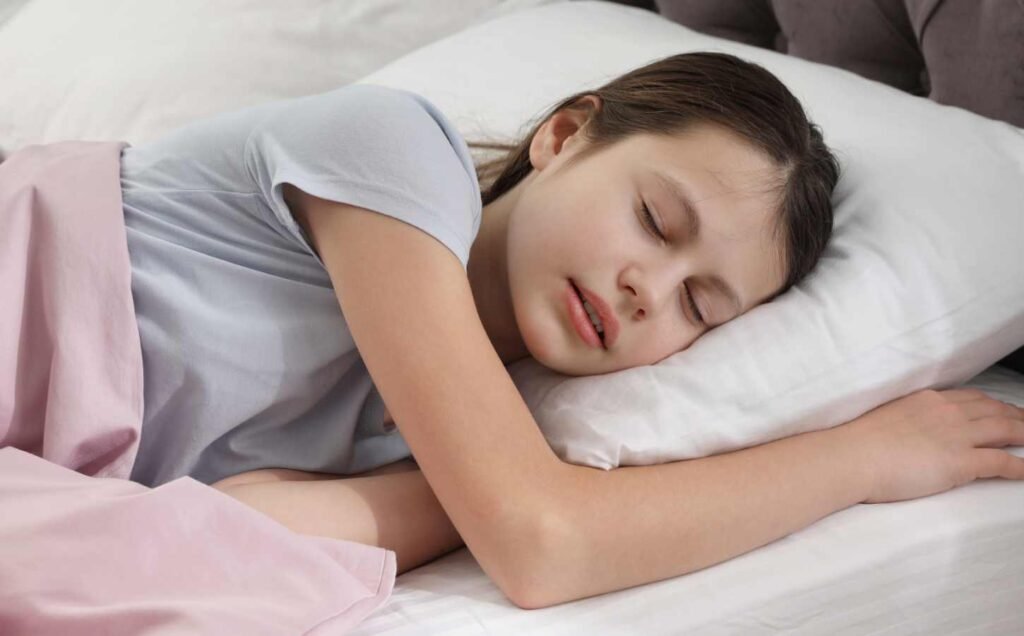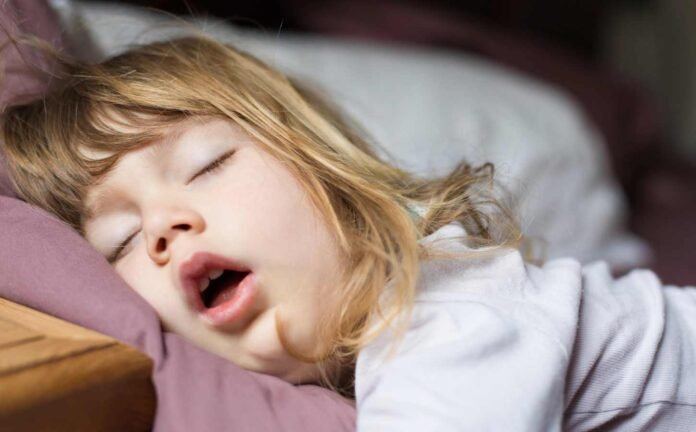Primary snoring in children is a common condition that affects approximately 10% of children.
It is characterized by loud, regular snoring without any other symptoms of sleep-disordered breathing, such as pauses in breathing or gasping for air. While primary snoring is generally considered benign, it can still have negative effects on a child’s health and quality of life.
Childhood snoring can have a variety of causes, including enlarged tonsils and adenoids, obesity, and certain medical conditions. Primary snoring, however, is not associated with any underlying medical problems and is thought to be related to the anatomy and muscle tone of the upper airway. It is more common in boys than girls and tends to peak between the ages of 2 and 6 years old.
Parents and caregivers should be aware of the potential impact of primary snoring on a child’s health and well-being. While it may not be a sign of a serious underlying condition, it can still lead to daytime sleepiness, behavioral problems, and poor academic performance. It is important to consult a healthcare provider if a child’s snoring is persistent or accompanied by other symptoms of sleep-disordered breathing.
Understanding Primary Snoring
Definition and Prevalence
Primary snoring is a common condition in which a child snores during sleep without any signs of breathing difficulties or interruptions. It is estimated that about 10% to 12% of children snore regularly, and primary snoring accounts for about 85% of all snoring cases in children.
Causes of Primary Snoring
The exact cause of primary snoring in children is not fully understood. However, it is thought to be related to the anatomy of the upper airway, which can narrow during sleep and cause vibrations in the tissues, resulting in snoring. Other factors that may contribute to primary snoring in children include obesity, family history of snoring, and certain medical conditions such as allergies and asthma.
Differences Between Primary Snoring and Obstructive Sleep Apnea
Primary snoring is different from obstructive sleep apnea (OSA), which is a more serious condition that involves complete or partial blockage of the upper airway during sleep, leading to disrupted breathing and oxygen deprivation. Unlike primary snoring, OSA is associated with symptoms such as gasping, choking, and pauses in breathing during sleep, as well as daytime sleepiness and behavioral problems.
It is important to differentiate between primary snoring and OSA, as OSA requires prompt medical attention and treatment. A sleep study may be necessary to diagnose OSA and determine the appropriate treatment.
In summary, primary snoring is a common condition in which a child snores during sleep without any signs of breathing difficulties or interruptions. While the exact cause of primary snoring is not fully understood, it is thought to be related to the anatomy of the upper airway. It is important to differentiate between primary snoring and OSA, as OSA requires prompt medical attention and treatment.
Symptoms and Diagnosis
Recognizing Snoring Symptoms in Children
Primary snoring in children is characterized by loud, regular snoring during sleep, without any other associated symptoms such as pauses in breathing, gasping, or choking sounds. It is important to note that not all children who snore have primary snoring, and some may have underlying conditions that require medical attention.
Other symptoms that may be associated with primary snoring in children include:
- Restless sleep
- Mouth breathing
- Difficulty falling asleep
- Waking up frequently during the night
- Daytime sleepiness
- Behavioral problems
- Poor school performance
When to Consult a Pediatrician or ENT Specialist
If parents or caregivers notice any of the above symptoms in their child, they should consult a pediatrician or an ENT (ear, nose, and throat) specialist. The doctor will perform a physical examination of the child’s nose, mouth, and throat, and may recommend further tests to diagnose the underlying cause of the snoring.
Diagnostic Procedures
Polysomnography, also known as a sleep study, is the gold standard for diagnosing primary snoring in children. This test measures various physiological parameters during sleep, such as brain waves, eye movements, muscle activity, and breathing patterns.
In addition to polysomnography, other diagnostic tests that may be used to evaluate primary snoring in children include:
- Nasal endoscopy: A thin, flexible tube with a camera is inserted through the nose to examine the nasal passages and throat.
- Imaging studies: X-rays, CT scans, or MRI scans may be used to evaluate the structure of the airway and identify any abnormalities.
- Allergy testing: If allergies are suspected to be a contributing factor to the snoring, skin or blood tests may be performed to identify the allergen.
Overall, early recognition and diagnosis of primary snoring in children is important to prevent potential complications and improve the child’s quality of life.
Risk Factors and Complications
Role of Tonsils and Adenoids
Enlarged tonsils and adenoids are common risk factors for primary snoring in children. These structures can obstruct the airway during sleep, causing snoring and disrupted breathing patterns. Tonsillectomy and adenoidectomy are common surgical interventions for children with obstructive sleep apnea, a severe form of snoring that can lead to long-term health complications.
Impact of Allergies and Obesity
Allergies and obesity are also risk factors for primary snoring in children. Allergic reactions can cause inflammation in the nasal passages, leading to snoring and disrupted breathing during sleep. Obesity can contribute to snoring by increasing the amount of soft tissue in the throat, which can obstruct the airway.
Potential Complications of Untreated Snoring
Untreated snoring in children can lead to a number of potential complications. Chronic snoring can disrupt sleep patterns, leading to daytime fatigue and poor academic performance. Snoring can also lead to behavioral problems and mood disturbances in children.
In addition, untreated snoring can lead to long-term health complications, including high blood pressure, heart disease, and stroke. Children with severe snoring may also be at risk for developing obstructive sleep apnea, a condition that can cause breathing cessation during sleep and lead to serious health complications.
Overall, it is important for parents to be aware of the risk factors and potential complications associated with primary snoring in children. By seeking medical attention and appropriate treatment, parents can help prevent long-term health complications and improve their child’s quality of life.
Treatment Options
Primary snoring in children can be managed through a variety of treatment options that are tailored to the underlying cause of the condition. The treatment plan should be developed in consultation with a healthcare professional, who will consider the severity of the snoring, the child’s age, and any underlying medical conditions.
Lifestyle Changes and Home Remedies
In some cases, primary snoring in children can be managed through lifestyle changes and home remedies. These may include:
- Encouraging the child to sleep on their side rather than their back
- Maintaining a consistent sleep schedule
- Limiting screen time before bed
- Keeping the bedroom cool, quiet, and dark
- Encouraging regular exercise and physical activity
- Reducing the child’s exposure to allergens and irritants
- Using a humidifier to keep the air moist
Medical Interventions
If lifestyle changes and home remedies are not effective, medical interventions may be necessary. These may include:
- Medications: Certain medications may be prescribed to reduce inflammation or to treat underlying medical conditions that contribute to snoring.
- Positive airway pressure (PAP) therapy: This involves the use of a machine that delivers air pressure through a mask to keep the airway open during sleep. Continuous positive airway pressure (CPAP) is one type of PAP therapy that is commonly used to treat obstructive sleep apnea.
- Weight loss: If the child is overweight or obese, weight loss may be recommended to reduce the amount of tissue in the throat that contributes to snoring.
Surgical Procedures
In some cases, surgical procedures may be necessary to treat primary snoring in children. These may include:
- Adenotonsillectomy: This involves the removal of the adenoids and tonsils, which can help to open up the airway and reduce snoring.
- Other surgical procedures: In some cases, other surgical procedures may be necessary to address structural abnormalities in the nose, mouth, or throat that contribute to snoring.
It is important to note that not all children with primary snoring require treatment. However, if left untreated, snoring can lead to more serious health problems, such as obstructive sleep apnea. Therefore, it is important to consult with a healthcare professional if your child is experiencing persistent snoring.
Management and Prevention
Improving Sleep Hygiene
Primary snoring in children can often be managed through simple changes in sleep hygiene. Parents should ensure that their child has a consistent sleep schedule, with a regular bedtime and wake-up time. They should also encourage their child to establish a relaxing bedtime routine, such as taking a warm bath or reading a book.
It is important to create a sleep-conducive environment by keeping the bedroom cool, dark, and quiet. Limiting screen time before bed can also be helpful, as the blue light emitted by electronic devices can interfere with sleep.
Monitoring and Follow-Up Care
Primary care providers play an important role in the management of primary snoring in children. They can monitor the child’s symptoms and refer them to a sleep specialist if necessary.
Follow-up care is important to ensure that the child’s symptoms are improving and to address any new concerns. Parents should be encouraged to keep a sleep diary to track their child’s sleep patterns and to report any changes to their healthcare provider.
Preventive Strategies
Preventive strategies can help reduce the risk of primary snoring in children. A healthy diet and regular exercise can promote overall health and reduce the risk of obesity, which is a common risk factor for snoring.
Encouraging children to sleep on their side or stomach can also be helpful, as sleeping on the back can worsen snoring. Additionally, environmental control measures such as using a humidifier or air purifier can improve air quality and reduce the risk of snoring.
In summary, primary snoring in children can often be managed through simple changes in sleep hygiene, monitoring and follow-up care, and preventive strategies. Primary care providers and sleep specialists can work together with parents to develop a personalized management plan for each child.
Associated Conditions and Behavioral Impact
Sleep Disorders and Cognitive Effects
Primary snoring in children can lead to various sleep disorders and cognitive effects. Snoring can cause sleep fragmentation, leading to daytime sleepiness and fatigue. Children with primary snoring may also experience obstructive sleep apnea (OSA), which can cause pauses in breathing during sleep and lead to oxygen deprivation. OSA has been linked to cognitive deficits and behavioral issues such as hyperactivity, inattention, and poor academic performance.
Studies have shown that children with primary snoring may have a higher risk of developing OSA, which can exacerbate cognitive and behavioral problems. It is important to screen children with primary snoring for OSA and other sleep disorders to prevent long-term cognitive and behavioral effects.
Behavioral Problems and ADHD
Primary snoring in children can also lead to behavioral problems and attention-deficit/hyperactivity disorder (ADHD). Children with primary snoring are more likely to exhibit behavioral issues such as aggression, hyperactivity, and inattention. These behavioral problems can affect academic performance and social relationships.
Studies have shown that primary snoring is associated with a higher risk of developing ADHD. Children with primary snoring and ADHD may benefit from treatment with continuous positive airway pressure (CPAP) therapy or other interventions to improve sleep quality and reduce daytime symptoms.
In conclusion, primary snoring in children can lead to various associated conditions and behavioral impacts, including sleep disorders, cognitive deficits, and behavioral problems such as ADHD. It is important to screen children with primary snoring for these conditions and provide appropriate interventions to prevent long-term effects on health and well-being.
Related article: ADHD and Sleep Disorders: Understanding the Connection
Support and Resources
Educational Materials and Support Groups
Parents of children who snore may find it helpful to access educational materials and support groups to learn more about primary snoring and its management. There are several resources available online and in-person that can provide information and support to families.
The American Sleep Apnea Association (ASAA) offers a variety of resources for parents and families, including educational materials, webinars, and support groups. The ASAA website also provides a directory of sleep centers and specialists who can help diagnose and treat primary snoring in children.
The National Sleep Foundation (NSF) is another resource for parents seeking information about primary snoring in children. The NSF website provides educational materials and resources for parents, as well as a directory of sleep centers and specialists.
Finding a Sleep Specialist or Pediatric Otolaryngologist
If a child’s primary snoring is causing significant disruption to their sleep or quality of life, it may be necessary to consult with a sleep specialist or pediatric otolaryngologist. These specialists can help diagnose the underlying cause of primary snoring and recommend appropriate treatment options.
Parents can find a sleep specialist or pediatric otolaryngologist by asking for a referral from their child’s primary care physician or by using online directories provided by organizations such as the ASAA or NSF. It is important to choose a specialist who is experienced in treating primary snoring in children and who can provide comprehensive care and support.
In conclusion, there are several resources available to parents of children who snore, including educational materials, support groups, and directories of sleep specialists and pediatric otolaryngologists. By accessing these resources, parents can learn more about primary snoring and its management, and find the support they need to help their child get a good night’s sleep.
Frequently Asked Questions
What are the common causes of snoring in children?
Primary snoring in children can be caused by a variety of factors, including anatomical abnormalities, obesity, allergies, and respiratory infections. In some cases, snoring may be a sign of a more serious condition, such as sleep apnea.
How can snoring be treated in children?
Treatment for snoring in children depends on the underlying cause. In some cases, lifestyle changes such as weight loss or changes in sleeping position may be effective. Other treatments may include medications, surgery, or the use of a continuous positive airway pressure (CPAP) machine.
When should I be concerned about my child’s snoring?
Parents should be concerned about their child’s snoring if it is loud, frequent, or accompanied by other symptoms such as gasping, choking, or pauses in breathing during sleep. These may be signs of sleep apnea, which can have serious health consequences if left untreated.
What home remedies can help reduce snoring in children?
There are several home remedies that may help reduce snoring in children, including maintaining a healthy weight, avoiding allergens, and using a humidifier in the bedroom. However, it is important to consult with a healthcare professional before attempting any home remedies.
How does enlarged adenoids affect a child’s snoring and sleep?
Enlarged adenoids can block the airway and cause snoring and other sleep disturbances in children. In some cases, surgical removal of the adenoids may be necessary to alleviate these symptoms.
What are the possible complications of untreated snoring in children?
Untreated snoring in children can lead to a variety of complications, including poor sleep quality, behavioral problems, and developmental delays. In some cases, it may also lead to more serious health problems such as high blood pressure, heart disease, and stroke later in life. It is important to seek medical attention if your child is experiencing frequent or loud snoring.
Sleep Disordered Breathing in Children: Causes and Treatment Options

It is estimated that up to 10% of children may have some form of Sleep Disordered Breathing, although many cases go undiagnosed and untreated. As a result, it is important for parents and healthcare providers to be aware of the signs and symptoms of Sleep Disordered Breathing and to seek appropriate evaluation and treatment when necessary.
Continue reading: Sleep Disordered Breathing in Children
Pediatric Sleep Apnea: Causes, Symptoms, and Treatment Options

Pediatric sleep apnea is a sleep disorder that causes a child to stop breathing repeatedly during sleep. This condition occurs when the muscles in the back of the throat fail to keep the airway open, leading to a blockage in the air passage. The child may snore loudly, gasp, or choke during sleep, and may also experience disrupted sleep, leading to daytime sleepiness and other complications.
Continue reading: Pediatric Sleep Apnea
Zarbee’s Kids Melatonin Sleep Gummies for Toddlers*

Are you a parent struggling to get your child to sleep at night? We’ve recently tried out Zarbee’s Kids 1mg Melatonin Sleep Gummies for toddlers, and we’re impressed with the results.
One of the best features of Zarbee’s Kids 1mg Melatonin Gummy* is that it’s pediatrician-approved. The brand was developed by a father and pediatrician, Dr. Zak Zarbock, and has become the #1 Pediatrician Recommended Sleep Support Brand for Children.
*As an Amazon.com Affiliate, we may earn a small commission if you buy from a link within this page.



